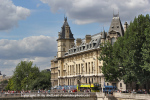Другие журналы

Filimonov
Comparative Signal-to-Noise Ratio Assessment for the Atmospheric Sounder Lidars with Eye-Safe Laser Wavelengths
Engineering Education # 09, September 2016
DOI: 10.7463/0916.0845030
Engineering Education # 09, September 2016
DOI: 10.7463/0916.0845030
pp. 24-34
Analysis of Lidar Receiver Saturation Zone Versus Atmosphere and Lidar Parameters in UV Spectral Band
Engineering Education # 03, March 2016
DOI: 10.7463/0316.0835419
Engineering Education # 03, March 2016
DOI: 10.7463/0316.0835419
pp. 180-196
Field Measuring Statistical Properties of Atmospheric Aerosol Inhomogenuity in Optical Spectral Band
Radiooptics # 05, September 2015
DOI: 10.7463/rdopt.0515.0793200
Radiooptics # 05, September 2015
DOI: 10.7463/rdopt.0515.0793200
pp. 115-127
Laser Meter of Atmospheric Inhomogenuity Properties in UV Spectral Band
Radiooptics # 02, March 2015
DOI: 10.7463/rdopt.0215.0782060
Radiooptics # 02, March 2015
DOI: 10.7463/rdopt.0215.0782060
pp. 32-46
Laser Meter of Atmospheric Inhomogeneity Properties in UV Spectral Range
Engineering Education # 04, April 2015
DOI: 10.7463/0415.0764586
Engineering Education # 04, April 2015
DOI: 10.7463/0415.0764586
pp. 155-170
Сomparative Analysis of Sounding Range for Aerosol Lidar Alternate Designs
Engineering Education # 01, January 2015
DOI: 10.7463/0115.0754084
Engineering Education # 01, January 2015
DOI: 10.7463/0115.0754084
pp. 114-128
Estimating a Wind Shear Detection Range for Different Altitude Levels in the Troposphere
Engineering Education # 06, June 2014
DOI: 10.7463/0614.0715345
Engineering Education # 06, June 2014
DOI: 10.7463/0614.0715345
The paper presents estimation of a sounding range of the airborne lidar in ultraviolet, visible, and near infrared spectral bands to solve a problem of wind shear detection for different altitude levels in the troposphere. It is shown that with the flying altitude rise there is a decrease of the sounding range, most of all, within the altitude of 5-10 km. This dependence is explained by the fact that in this range of altitudes there is a substantial decrease of aerosol scattering and extinction coefficients in the earth atmosphere with the increase of altitude. In the lowest atmospheric layer the sounding range reaches maximum for the wavelengths of 0.532 µm. With increase of flying altitude a difference between the sounding ranges for the wavelengths of 0.355, 9.532, and 1.54 µm decreases.
Сomparison of calculation procedure of minimum detectable energy for photomultiplier tube
Engineering Bulletin # 04, April 2014
УДК: 551.501
Engineering Bulletin # 04, April 2014
УДК: 551.501
In this paper comparative analysis of calculation procedure of minimum detectable energy for photomultiplier tube in ultraviolet, visible and near infrared bands is considered. It is shown that calculation data of minimum detectable energy for photomultiplier tube in UV, visible band and near IR bands may be not equal for various calculation procedure. The difference in that calculation data the more, the more signal-to-noise ratio. As the spectral filter bandwidth, field of receiver or detection time are increased then minimum detectable energy for photomultiplier tube is increased and difference in that calculation data for various calculation procedure is decreased.
Сomparative analysis of wind correlation lidar sounding range in UV, visible band and near IR bands
Engineering Education # 02, February 2014
DOI: 10.7463/0214.0696580
Engineering Education # 02, February 2014
DOI: 10.7463/0214.0696580
The paper presents a comparative analysis of the sounding range of wind correlation lidar in ultraviolet, visible, and near infrared spectral bands. It shows that a visible spectral band is the most advanced one to provide a maximum sounding range of wind correlation lidar in earth atmosphere. If there are specific requirements for wind correlation lidar, for example, a requirement is that a wind correlation lidar should operate at the eye-safe laser sounding wavelength then the efficient work of wind correlation lidar may be maintained in ultraviolet and near infrared spectral bands with the sounding range reduced a little bit.
| Authors |
| Press-releases |
| Library |
| Conferences |
| About Project |
| Phone: +7 (915) 336-07-65 (строго: среда; пятница c 11-00 до 17-00) |
|
||||
| © 2003-2024 «Наука и образование» Перепечатка материалов журнала без согласования с редакцией запрещена Phone: +7 (915) 336-07-65 (строго: среда; пятница c 11-00 до 17-00) | |||||



